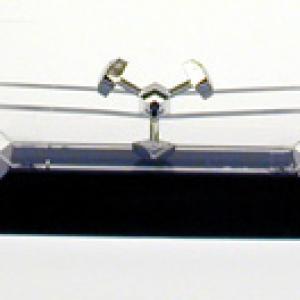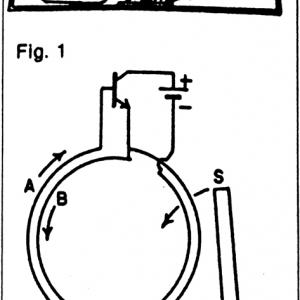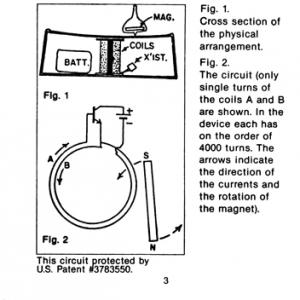College of Liberal Arts & Sciences
5K40.49c - Space Wheel
See also 5K40.49c in Perpetual Motion.
These demos are specially designed brushless DC electric motors. The moving parts have magnets in them and correspond to the rotor and flywheel of the motor. The base of the demo contains a battery, coil, steel core, and a transistor. The moving rotor induces an electric current in the coil. This current is amplified and fed into an electromagnet which applies a torque to the magnetic rotor, which in this case has a magnet in each of the three arms.
NOTE: Be gentle with the rails of the demo. The tabs which connect the rails to the base are particularly fragile. The battery will last for 6 or 7 months of continuous use. The rails may have to be cleaned of dust periodically.
- Larry K. Smith, "A Better Explanation on the Perpetual Motion Simulator", TPT, Vol. 62, #6, Sept. 2024, p. 421.
- Hollis Williams, "A "Perpetual Motion Machine" Powered by Electromagnetism", TPT, Vol. 62, #1, Jan. 2024, p. 47.
- Gerrard Lietz and Tony Behof, "A Double Wheel", TPT, Vol. 22, # 5, May 1984, p. 324 - 325.
- Arthur Schmidt, Peter Insley, "Perpetual (?) Spinning", TPT, Vol. 22, # 9, Dec. 1984, p. 594.
- H. Richard Crane, "A Spinning Top, Lenz's Law and Electric Watches", TPT, Vol. 22, # 2, Feb. 1984, p. 113.
- Maurice Bruce Stewart, "The Marquess of Worcester's Perpetual Motion Machine", TPT, Vol. 19, # 1, Jan. 1981, p. 37.
- Allen S. Hsiao, "Today's Panacea", TPT, Vol. 19, # 5, May 1981, p. 282.
- Jearl Walker, "Motors in Which Magnets Attract Other Magnets in Apparent Perpetual Motion", The Amateur Scientist, March, 1982.
- C.L. Stong, "An Electrometer, a Temperature Control Apparatus, and a Simple Electric Motor", The Amateur Scientist, October, 1965.
Disclaimer: These demonstrations are provided only for illustrative use by persons affiliated with The University of Iowa and only under the direction of a trained instructor or physicist. The University of Iowa is not responsible for demonstrations performed by those using their own equipment or who choose to use this reference material for their own purpose. The demonstrations included here are within the public domain and can be found in materials contained in libraries, bookstores, and through electronic sources. Performing all or any portion of any of these demonstrations, with or without revisions not depicted here entails inherent risks. These risks include, without limitation, bodily injury (and possibly death), including risks to health that may be temporary or permanent and that may exacerbate a pre-existing medical condition; and property loss or damage. Anyone performing any part of these demonstrations, even with revisions, knowingly and voluntarily assumes all risks associated with them.


